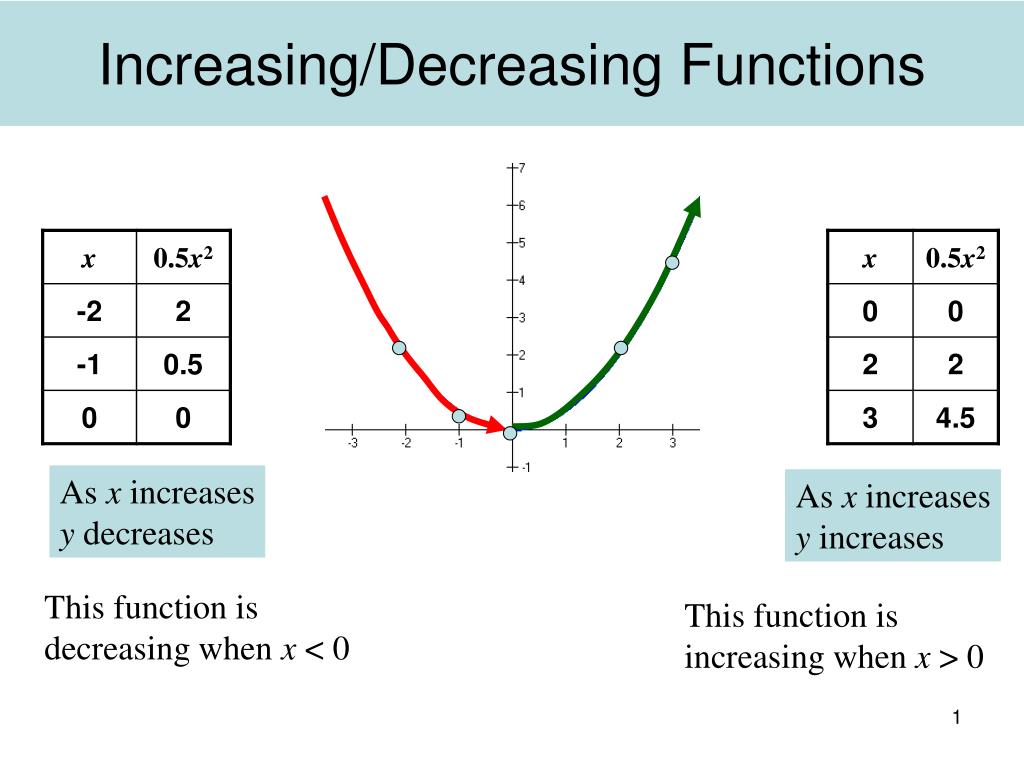Increasing and decreasing functions are functions whose graphs go upwards and downwards respectively as we move towards the right-hand side of the x-axis. Increasing and decreasing functions are also called non-decreasing and non-increasing functions.
Increasing and Decreasing Functions – ppt download
Jan 18, 2024A function decreases on an interval if for all , where .If for all , the function is said to be strictly decreasing.. Conversely, a function increases on an interval if for all with .If for all , the function is said to be strictly increasing.. If the derivative of a continuous function satisfies on an open interval, then is decreasing on .However, a function may decrease on an interval

Source Image: slideserve.com
Download Image
Mar 27, 2022The formal definition of an increasing interval is: an open interval on the x axis of (a,d) where every b,c∈ (a,d) with b<c has f (b)≤f (c). [Figure2] A interval is said to be strictly increasing if f (b)<f (c) is substituted into the definition. Decreasing means places on the graph where the slope is negative.

Source Image: byjus.com
Download Image
5.1 Increasing\decreasing Functions Find critical values of a function Find increasing/decreasing intervals of a function. – ppt download Increasing is where the function has a positive slope and decreasing is where the function has a negative slope. A common misconception is to look at the squaring function and see two curves that symmetrically increase away from zero.

Source Image: chegg.com
Download Image
For Which Of The Following Decreasing Functions Does
Increasing is where the function has a positive slope and decreasing is where the function has a negative slope. A common misconception is to look at the squaring function and see two curves that symmetrically increase away from zero. The xaxis scales by one, and the y-axis scales by zero point five. The graph of y equals h of x is a continuous curve. From left to right, it passes through the point negative four, zero point seven-five and the x-intercept negative three, zero. It continues to decrease until the local minimum at negative one point five, negative one.
Solved Let g be a function that is decreasing for x < 0 and | Chegg.com
doctorfoxphd 8 years ago That is true, if the parabola is upward-facing and the vertex is above the x-axis, there would not be an interval where the function is negative. You have to be careful about the wording of the question though. Increasing and Decreasing Functions in Calculus- Definition & Examples

Source Image: byjus.com
Download Image
Increasing and Decreasing Functions – Precalculus Tips – YouTube doctorfoxphd 8 years ago That is true, if the parabola is upward-facing and the vertex is above the x-axis, there would not be an interval where the function is negative. You have to be careful about the wording of the question though.

Source Image: youtube.com
Download Image
Increasing and Decreasing Functions – ppt download Increasing and decreasing functions are functions whose graphs go upwards and downwards respectively as we move towards the right-hand side of the x-axis. Increasing and decreasing functions are also called non-decreasing and non-increasing functions.

Source Image: slideplayer.com
Download Image
5.1 Increasing\decreasing Functions Find critical values of a function Find increasing/decreasing intervals of a function. – ppt download Mar 27, 2022The formal definition of an increasing interval is: an open interval on the x axis of (a,d) where every b,c∈ (a,d) with b<c has f (b)≤f (c). [Figure2] A interval is said to be strictly increasing if f (b)<f (c) is substituted into the definition. Decreasing means places on the graph where the slope is negative.

Source Image: slideplayer.com
Download Image
3.3 Increasing and Decreasing Functions and the First Derivative Test – ppt download The linear functions we used in the two previous examples increased over time, but not every linear function does. A linear function may be increasing, decreasing, or constant. For an increasing function, as with the train example, the output values increase as the input values increase. The graph of an increasing function has a positive slope

Source Image: slideplayer.com
Download Image
Increasing and Decreasing Functions in Calculus- Definition & Examples Increasing is where the function has a positive slope and decreasing is where the function has a negative slope. A common misconception is to look at the squaring function and see two curves that symmetrically increase away from zero.

Source Image: byjus.com
Download Image
Increasing and Decreasing Functions | Pre-Calculus – YouTube The xaxis scales by one, and the y-axis scales by zero point five. The graph of y equals h of x is a continuous curve. From left to right, it passes through the point negative four, zero point seven-five and the x-intercept negative three, zero. It continues to decrease until the local minimum at negative one point five, negative one.

Source Image: youtube.com
Download Image
Increasing and Decreasing Functions – Precalculus Tips – YouTube
Increasing and Decreasing Functions | Pre-Calculus – YouTube Jan 18, 2024A function decreases on an interval if for all , where .If for all , the function is said to be strictly decreasing.. Conversely, a function increases on an interval if for all with .If for all , the function is said to be strictly increasing.. If the derivative of a continuous function satisfies on an open interval, then is decreasing on .However, a function may decrease on an interval
5.1 Increasing\decreasing Functions Find critical values of a function Find increasing/decreasing intervals of a function. – ppt download Increasing and Decreasing Functions in Calculus- Definition & Examples The linear functions we used in the two previous examples increased over time, but not every linear function does. A linear function may be increasing, decreasing, or constant. For an increasing function, as with the train example, the output values increase as the input values increase. The graph of an increasing function has a positive slope